The now thirteen annual reincarnations of the 9/11 Table of Silence Project, conceived and choreographed by Jacqulyn Buglisi and presented each year on the morning of September 11 across the entire main expanse surrounding the fountain at the center of Lincoln Center’s Josie Robertson Plaza, have arguably grown into the artist’s magnum opus.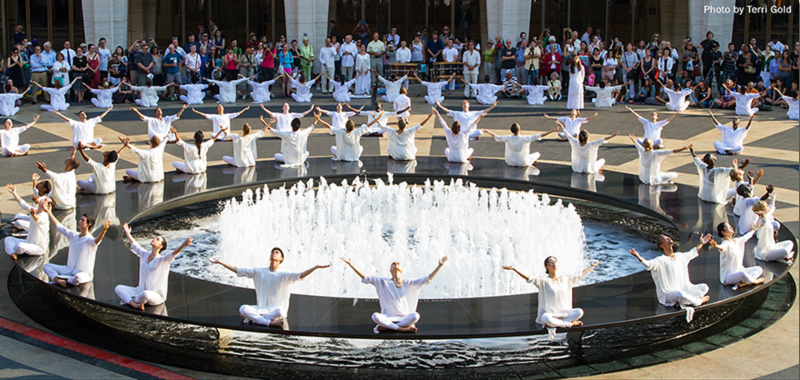
The work already involved more than 100 dancers in its very first iteration, which marked the 10th anniversary of the terrorist attacks of 2001. This year the 152 dancers, 7 musicians, 5 acapella singers and dozens of support and live streaming staff, security personnel and volunteers of the 13th edition, not to mention ceramic sculptural artist Rossella Vasta and her principal fabricator Fausto Bizzirri, costume designer A. Christina Giannini along with Alessandro Gherardi and assistants must bring the total number of people involved directly in the various manifestations of the production to over a thousand across the life of the project. The dancers alone each year have numbered between 129 and 182 and have included adults of all ethnicities and ages with and without apparent disabilities. The youngest among them would not even have been born on that fateful day 22 years ago.
The project has spawned a commemorative book designed and produced by photographer Paul B. Goode in collaboration with Buglisi Dance Theatre, as well as a comprehensive series of videos by Nel Shelby Productions that document the development of the work year by year. Shelby, like Goode, has been a presence all along, and her annual video translations, livestreamed on Youtube, Facebook Live, and Lincoln Center’s own streaming service have now reached people in 235 countries/territories globally as well as all 50 states in the U.S.
In 2020, in the teeth if the pandemic lockdown, the Arnhold Dance Innovation Fund came aboard as lead financial supporter and the work bloomed anew. A reimagined Table of Silence featured a new “Prologue” limited to 28 dancers to accommodate pandemic restrictions and adding live performance by Daniel Bernard Roumain (DBR) of his “Our Country” and the spoken word composition “Awakening” created and performed by Marc Bamuthi Joseph. These artists reappeared in 2021 with 36 dancers while the “Prologue; Improvisation” section that opened this year’s 9/11 iteration included elements of the 2020 and 2021 reimagined 9/11 Table of Silence Project prologue with DBR but without Bamuthi Joseph.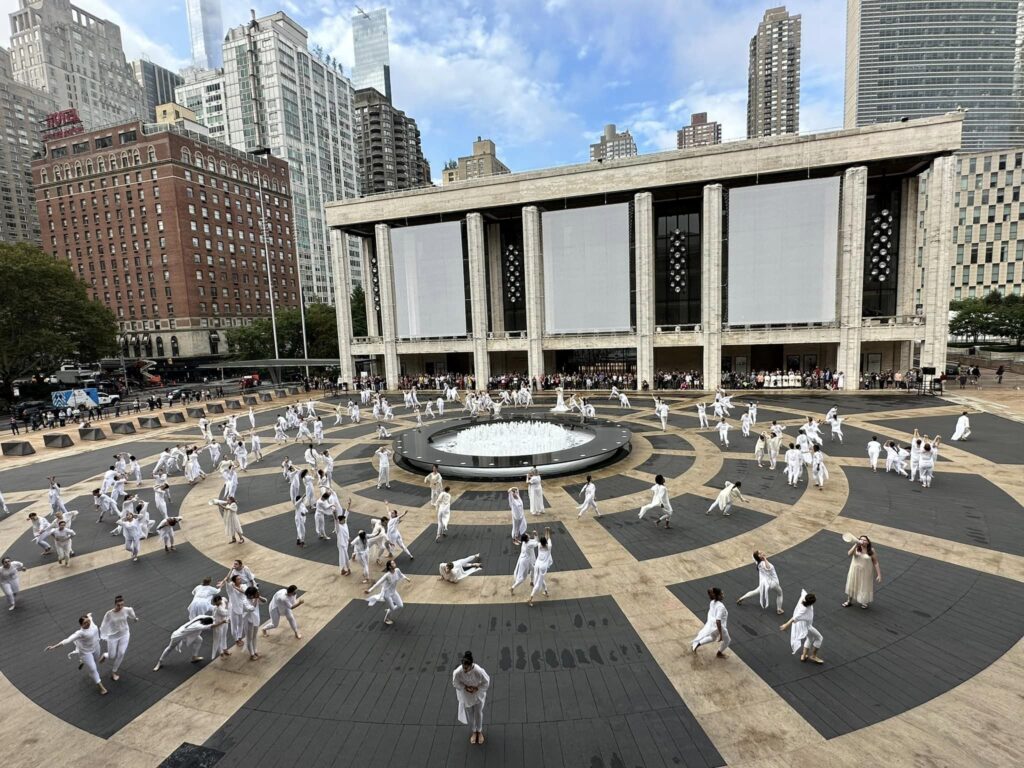
Photo by Josef Pinlac: Visual descriptions of both photos at bottom below.
Lincoln Center has begun, over the course of the pandemic pause, to come to grips with its architectural and social justice legacy. It has, over that time, witnessed both the delayed release of Steven Spielberg’s remake of West Side Story set in a contemporary cinematic recreation of San Juan Hill, the neighborhood the complex supplanted, and the remodeling of what has been renamed David Geffen Hall with artist Nina Chanel Abney’s monumental “San Juan Heal” installed in its uptown-facing façade windows.
In considering the mid-1960’s opening of Lincoln Center for the Performing Arts in the wake of Robert Moses’ “slum clearance” of a poor but vital neighborhood, New York Times architecture critic Ada Louise Huxtable wrote that “Philharmonic Hall, the State Theater, and the Metropolitan Opera are lushly decorated, conservative structures that the public finds pleasing and most professionals consider a failure of nerve, imagination and talent… Fortunately, the scale and relationship of the plazas are good, and they can be enjoyed as pedestrian open spaces.”
In the decades since Huxtable’s words appeared, I have seen and participated in the use of the fountain plaza for Lincoln Center Out of Doors events, a huge nuclear disarmament demonstration, Midsummer Nights’ Swing, Met Opera film projections, David Michalek’s Slow Dancing installation, an artificial turf hangout, and Carl Hancock Rux’s Juneteenth extravaganza this June 18th, as well as the silent disco that it initiated. I have enjoyed most of these, especially MSNS and the work of the two artists. The art temples have been renamed for billionaires except for the Met. Nothing I have experienced there, however, makes more powerful use of what the American Institute of Architect’s AIA Guide to NYC terms “this travertine acropolis of music and theater” than the 9/11 Table of Silence Project in its most recent incarnation. (Does it seem a predictable omission that dance doesn’t figure in the AIA authors’ characterization of the “travertine acropolis” in spite of the fact that the home of constituent company New York City Ballet has been designed and has generally been used specifically for this discipline?)
Full disclosure: our Dancing Matters group had the privilege of accepting an invitation from Buglisi Dance Theatre to view the proceedings this September 11 from the balcony of David Geffen Hall. I have watched the ceremony unfold from the plaza level about a half dozen times over the years and have always found it moving. Only last Monday did the genius of Buglisi and her collaborators’ design and execution stand fully revealed to me. The choreographer’s use of architect Philip Johnson’s 12 tavertine spokes radiating from the fountain, the plaza at large, and the aprons of the Met and the steps leading up from Columbus Avenue, have developed continually over the life of the project. Last Monday this all seemed to work together with a bare bones but essential power that ultimately draws upon and projects what Buglisi calls the “mandala energy” of Johnson’s design. The intricacies of moving the performers in lines and patterns though and across this expanse maintained a mysterious but palpable tension throughout.
The most stunning revelation on this viewing, however, had to be the way the sound, mostly produced live and only intermittently with the aid of amplification, filled the entire acropolis to match the pulsing presence and movement of the dancers. Particularly effective: the blending of the five female vocal artists intoning their vocalese through large white paper hand-held megaphones. The impression of vulnerable humans set off by a vast formal cityscape found further enhancement in the relation of the Martha Graham reminiscent choreographic designs to the art-temple architecture. Centering this energy, Bell Master/Conductor/Principal Dancer Terese Capucilli and her mirroring bowl ringer and dancer Lauren Jaeger moved with a regal authority that punctuated the proceedings during their cross-fountain duet.
Martha Graham’s fascination with and reimagination of Greek myth from a female perspective proved a potent basis for this dancing. Both Buglisi and Capucilli, as members of Martha’s last company to whom the creator bequeathed queenly roles such as Jocasta, Clytemnestra and Medea, serve as vital links and heirs not only to Graham’s technique but her theatrical imagination. To see Capucilli embody this power and, together with Buglisi, draw this embodiment from within Jaeger, a generation younger, seems to reaffirm its place within a contemporary dance context. On the “tavertine acropolis,” the power of the Greek chorus and the basic elements of sound, sight and movement essential to the conjuring of tragedy toward catharsis could, in this moving ceremony and prayer for peace, all at once be glimpsed and fully felt.
I invite the other members of the Dancing Matters group to comment further as they may wish.
Upper Photo by Terri Gold showing the moment of silent prayer in which the dancers have opened their rounded arms beginning at shoulder level palms and faces lifted skyward in concentric circles on and around the central fountain.
Lower Photo by Josef Pinlac: Visual description: Looking south from a balcony perch, over 100 barefoot dancers in A, Chrstina Giaanini’s white surplices and white tights variously dance around the central black granite topped circle of the Revson fountain across the entire expanse of the Josie Robertson (main) Plaza at Lincoln Center joined by at least two identifiable singers in white holding large white paper acoustic megaphones to their mouths. The fountain burbles at the level of the black granite central disk upon which sit about 3 dozen of Rossella Vasta’s white ceramic dinner plates spaced at regular intervals. Twelve tavertine marble spokes radiate through the otherwise dark grey concrete floor of the plaza crossing four separate concentric tavertine rings each of greater circumference with the smallest hugging the base of the fountain. Visible in the background: broken white clouds in a blue sky over a part of the Midtown Manhattan skyline, the red brick Empire hotel, part of Dante Park, traffic on Columbus Avenue and, bordering the Plaza, the former New York State Theater with large blank muslin projection screens stretched almost entirely across its three main balcony openings. Between audience members lining Columbus Avenue and the plaza stands a line of evenly placed sculptural anti-vehicle barriers. Audience also fills the spaces under the balcony and the muslin screens with a solid line of nuns in white habits occupying half of the next to last portal to the right (west) in the image.

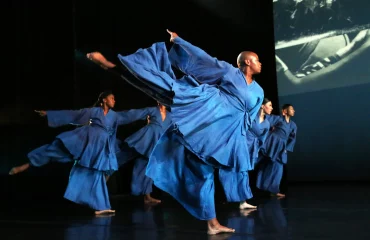
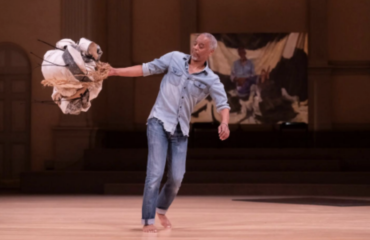
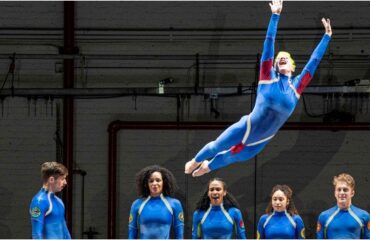
You must be logged in to post a comment.